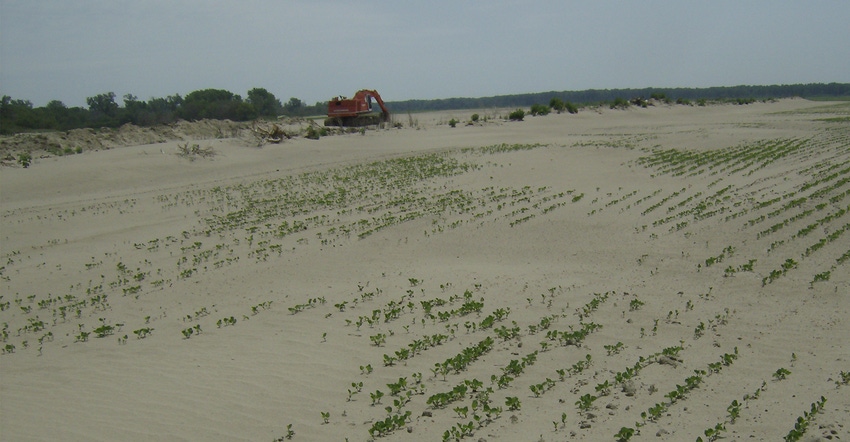
Not everyone was affected the same by 2019's flood events. Some Nebraska farm fields are dealing with sheet, rill and gully erosion, as well as sand, silt and debris deposition. In some places, the Missouri River likely will remain at high levels for months.
For fields that can't be planted this year, growers may have some questions: What can I do to fix the erosion on flooded fields? What do I do with all the sand deposited? How do I build the soil back up to preflood production?
Keep in mind this is an extreme flood event that often doesn't happen at this scale, and there isn't always a clear-cut answer to questions.
"When repairing major erosion, a lot of times the grower also has sediment deposited elsewhere in the field they can use to fill places where the floodwater eroded soil, creating gullies and scour holes," says John Wilson, Nebraska Extension educator in Burt County, where severe flooding has affected growers in 2019 and 2011, in addition to smaller flood events. "What we recommend is, if you've got a 10-foot gully created by the flood, fill up the first 7 feet with sediment deposited elsewhere in the field [if available], then use original topsoil from other parts of the field for the final 3 feet."
Wilson recommends incorporating shallow layers of sediment by tilling it into the native soil at 1.5 times the depth of the sediment being incorporated.
"So, if you have 4 inches of sediment on top of the soil that was deposited by flooding, you need to till about 10 inches deep, 4 inches through the sand, and 1.5 times that, or 6 inches into native soil to mix the two layers together," he explains. "The thickness of the layer of sediment you can incorporate will depend on the depth of tillage you can do with your equipment."
"That's the minimum,” Wilson adds. “The problem is if we don't incorporate it or just lightly incorporate the sediment, we create layers with sandier sediment and heavier soil below. If there's a difference in texture, it will affect rooting and water infiltration into the soil. That's why we recommend going 1.5 times the depth of the deposited sediment — so we get a fairly uniform mixture between the sediment and the native soil."
Of course, the cleanup process will be a long one — many who farm along the Missouri River still were moving sand and repairing erosion left by the 2011 flood for a year or two after the floodwaters receded.
"You may need to scrape off and move sand, stockpiling it in pivot corners or along the edges of fields so you can work around it," Wilson says. "We have some places where there are some large piles or windrows of sand that farmers pushed up on the edges or corners of fields after 2011, just to have room to farm the majority of their fields."
There also are options to plant cover crops on fields that won't be planted to cash crops this year. USDA's Natural Resources Conservation Service recently announced funding available to plant cover crops on fields damaged during the March 2019 flood event, with deadlines approaching May 17 and June 21.
Cover crops will add organic matter and may help improve the soil structure lost during the flooding. However, keep in mind that fields won't dry out evenly, and the entire field may not be ready to plant at the same time. This may determine how growers seed cover crops — whether aerially, broadcasting with a light incorporation, or drilling.
One challenge for establishing cover crops — or a cash crop — in the aftermath of a flood is the lack of residue on the soil to protect seedlings from water and wind erosion. However, one advantage of cover crops is even if only half a stand is established, it will help reduce the wind and water erosion, especially if planting a cash crop directly into the cover crop.
The species or species mix that growers plant will depend on when growers can get into the field, and what their goal is for the cover crops. Consider how using cover crops for livestock grazing will affect prevented planting payments.
"If growers are planting a cover crop for the whole growing season, use a mix of both grasses and broadleaves," Wilson says. "Broadleaves, including brassicas, have taproots that create macro pores, which improve infiltration and help break up compacted layers that may exist. Grasses will hold soil better, because their fibrous root system is denser."
In spring 2012, Wilson and a local farmer planted cover crops — including a mix of forage peas and oats, and straight oats — to see how cover crops prevented soil erosion and affected yields compared with bare soil. Cover crops were planted only a couple months before corn and soybeans were planted, and cover crops were terminated after crop emergence.
Wilson notes there was no difference between the two cover crop mixes, but cover crops prevented a substantial amount of soil erosion and had a positive effect on corn yields but were not significant on soybean yields.
"It caught blowing sand and soil from an area where the grower couldn't seed cover crops adjacent to our plots," Wilson says. "Where we had cover crops, they caught about 4 inches of sand and silt that was blowing from other areas in the field with no cover crops."
About the Author(s)
You May Also Like






